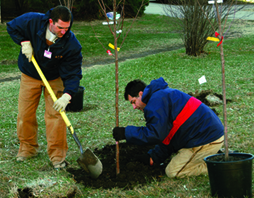An affirmation of beauty
It is one of K-State photographic services' most-requested images: Anderson Hall framed by bursts of orange, red and yellow, the trees putting on a final fall show before winter sends them into skeletal dormancy.
These oaks and hackberries represent a small fraction of the trees that add character and beauty to K-State's campus. Although many trees are bare by late November, for the campus facilities staff this is an active time of year.
 "Late fall is the best time of year to plant trees," said Jackie Toburen, assistant director of facilities services in charge of grounds. "The trees have become dormant, and they aren't putting any energy into producing and maintaining leaves, which makes it much easier for the tree to begin putting down roots."
"Late fall is the best time of year to plant trees," said Jackie Toburen, assistant director of facilities services in charge of grounds. "The trees have become dormant, and they aren't putting any energy into producing and maintaining leaves, which makes it much easier for the tree to begin putting down roots."
By the end of this year, off- campus contractors and K-State grounds crew will have planted more than 150 trees, a considerable increase over the annual average of 25.
"With the Jardine and Beach Museum expansion projects, there have been a lot more trees planted than normal," Toburen said.
The newly revamped Jardine Apartment Complex took 115 trees, Durland Plaza required 35, and two were planted north of Ahearn Field House. A memorial tree went in east of the Campus Creek Complex.
"When it comes to planting new trees, we try to focus on areas where we've had to take out trees," said John Woods, director of facilities services.
A tree of your own Anyone can buy a memorial tree or shrub for campus, said Dea Brokesh, a landscape architect with facilities planning, but there are guidelines: * Plantings must meet minimum size requirements. * Facilities planning must approve the species and location. * If the donor wishes to guarantee replacement of a damaged plant, a perpetual maintenance fund costs 25 percent of the planting's original retail price. * A commemorative plaque costs about $150, which includes replacement of a damaged plaque. For more information, call facilities planning, 532-6377. |
About 20 trees each year are removed because of construction or because they've died or become diseased, Woods said.
"Right now we have some mature pine trees that keep dying, so we have to take them out and replace them," he said.
The new pines are a disease-resistant hybrid, Toburen said.
Cleanup is another concern for facilities staff, who have worked with Charles Barden, an associate professor of horticulture, forestry and recreation, to plant male cottonwood seedlings.
"They don't produce the white cotton puffs," Toburen said. "We're trying those out on campus to see how they do."
K-State relies on landscape architects from facilities planning to decide which species of tree will be planted where, Toburen said.
Whatever the species, most trees to be planted come from local nurseries or Kansas contractors.
But anyone can contribute to the tree population, Woods said. (See sidebar.)
Buying a "memorial" tree allows a person to choose the species and the plaque to accompany it. "We call it a memorial, but people don't have to participate in the program just when someone is deceased," Woods said. "We've had people donate trees for graduation memorials or to honor retirement."
Since 1978 about 300 trees and shrubs have been donated to campus.
Photo: Dan McGee (left), plant science technician with facilities and grounds, and Mark Fronce, senior maintenance and repair technician, plant a Canada red cherry tree north of Ackert Hall.